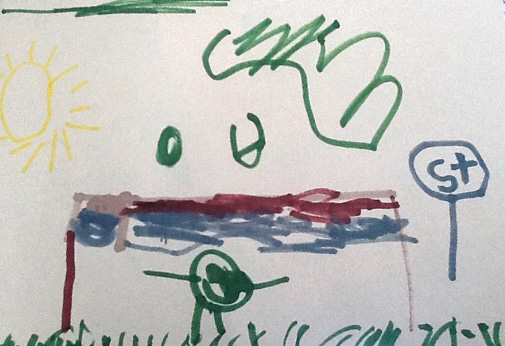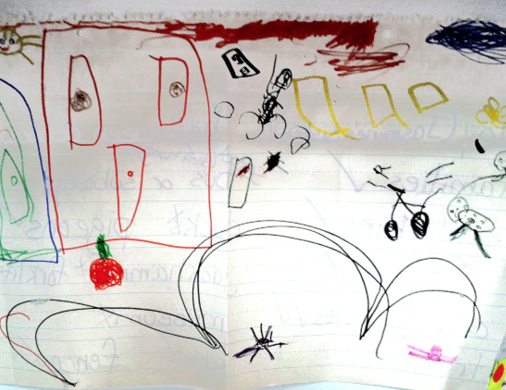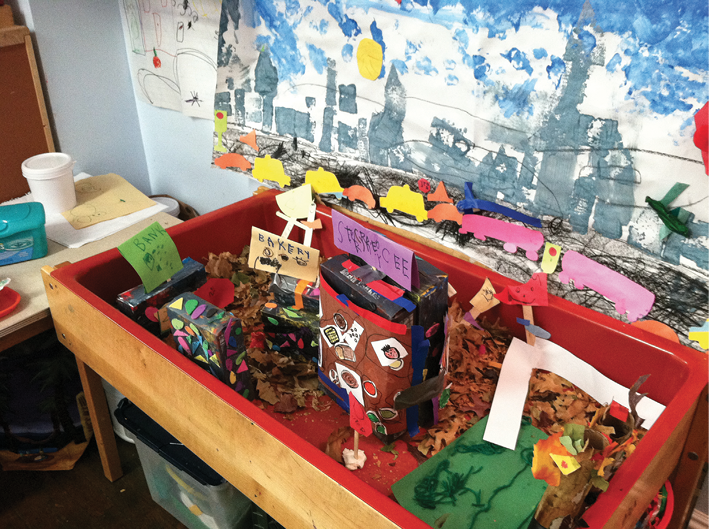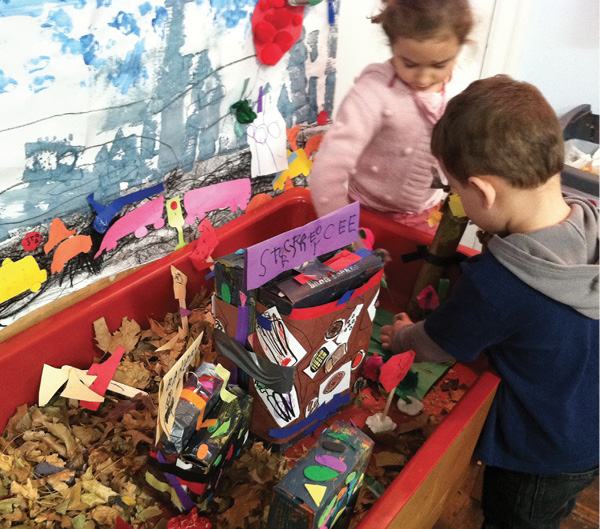Implementing the Project Approach in an Inclusive Classroom: A Teacher’s First Attempt With Project-Based Learning (Voices)

You are here
Thoughts on the Article | Barbara A. Henderson, Voices Executive Editor
Stacey Alfonso was teaching in an inclusion preschool in New York City, serving children with a range of special learning and developmental differences when she conducted this research. As she strove to embrace the child-centered inquiry that is at the heart of the project approach, she struggled with general expectations within her school culture that curriculum and instruction be teacher directed instead of cocreated with the children. Her teacher research makes a valuable contribution to the literature because she provides clear and believable examples of how the project approach worked for the children with special needs and examples of the challenges she faced due to the newness of her approach, her lack of mentors, and the varied learning strengths of the children. Stacey is especially effective in communicating the voices and work products of the children, showing how they are fully capable and eager to undertake inquiry and direct their own learning. Her trust in the children and her joy at their discoveries provided a turning point in her career that informs her current teaching in a forest school.
One of the biggest challenges I faced during my years teaching in an inclusive prekindergarten classroom was differentiating instruction. I was constantly searching for methods to engage all children because their wide range of abilities and needs required me to offer varied outlets for learning. My school held to a theme-based curriculum with a strong backbone of structure that guided classroom activities and children’s learning. I held to this approach as well, until, as I gained experience as an educator and learned more about child development, I began to question what I was doing and to seek alternative methods.
I wanted the children in my classroom to be motivated, authentically engaged, and excited to learn. I wanted them to take hold of their learning and drive their own experiences. The children were learning; still, I felt that their experiences should be more personal than I had been able to provide using a teacher-derived curriculum. I thought this could be best accomplished in an open-ended environment where children are free to explore and follow their interests. But how could this be done within my school’s current approach? I found my answer when I discovered the project approach.
The literature I read presented a pedagogy that would motivate and engage children with a diverse range of abilities, allowing them the freedom to explore their own interests, yet still provide enough structure to fit into my school’s current culture (Harris & Gleim 2008; Beneke & Ostrosky 2009; Katz, Chard, & Kogen 2014). My research question for this study was, How can I implement the project approach in my inclusive classroom in a preschool that has a history of structured, teacher-driven curriculum?
Review of literature
John Dewey was among the first to suggest that an ideal way for children to learn is by planning their own activities and implementing those plans, thereby providing opportunities for multilevel instruction, cooperative learning, peer support, and individualized learning (Harris & Gleim 2008). Today, many teachers find that project-based learning meets Dewey’s goals (Beneke & Ostrosky 2009; Yuen 2009; Brewer 2010). Overall, the project approach is viewed as empowering to children because they are active participants in shaping their own learning (Harris & Gleim 2008; Harte 2010; Helm & Katz 2011)
The project approach: A brief overview
The project approach seemed to be a good fit with my goal of finding a new way to engage and intrinsically motivate the children in my classroom, while meeting a wide range of needs. My research also suggested this approach would produce a well-organized curriculum that was straightforward to implement. The project approach involves children’s in-depth investigation of a worthwhile topic developed through authentic questions (Mitchell et al. 2009; Katz & Chard 2013). The teacher’s role is to support children through their inquiry. Teachers help children become responsible for their work, guide them to document and report their findings, and provide opportunities for choice (Katz & Chard 2013; Katz, Chard, & Kogen 2014).
I was encouraged that the project approach uses a specific three-phase design, because this structure seemed compatible with my school’s culture. During phase one, selecting a topic, teachers build common experiences by talking with children about their personal experiences to determine interests and helping children articulate specific questions as a topic emerges (Mitchell et al. 2009; Yuen 2010; Helm & Katz 2011; Katz & Chard 2013).
Phase two, data collection, emphasizes meaningful hands-on experiences. Children are researchers, gaining new information as they collect data to answer their questions. This phase is the bulk of the project investigation and takes place through direct and authentic experiences such as field trips, events, and interviews with visiting experts (Harte 2010; Katz & Chard 2013). Children can also gather data through secondary sources, including books, photos, videos, and websites.
Phase three, the culminating event, is a time to conclude the experience, usually through a summarizing event or activity (Mitchell et al. 2009). The children’s role continues to be central and the class often holds discussions on what they have learned to create a plan to share their insights (Harte 2010).
Methodology and research design
After reading extensively about the project approach, I felt ready to implement it in my classroom.
Setting and participants
I conducted my study in a small private preschool on the Upper West Side in New York City. The school has a decades-long history in the neighborhood, and families have come to trust and love the educators there. The school’s traditional curricular model of teacher-driven, thematic-based learning is well established and, as far as I know, had not been previously challenged or adapted.
Study participants included 13 pre-K children, my two coteachers, and myself. The children had a diverse range of abilities. Seven children had significant sensory processing issues, two had severe cognitive and language delays, and four had mild language delays and/or mild sensory processing issues. Most children who enroll at the school can attend and participate independently, although some require one-on-one support with a therapist.
Data collection and analysis
Throughout the study, I collected and analyzed data through field notes, a reflective journal, children’s work, and anecdotal records that included photos, videos, and audio recordings. My primary source of data was field notes, which I used to provide a day-to-day recollection of how the project-based curriculum affected the children. The Teacher Notes app on the iPad and iPhone helped me collect and analyze the field notes. I kept project planning journals using a notebook and the Evernote app on my iPad. The software provided me with flexibility because it was accessible via iPad, iPhone, and computer; therefore, I was able to take ample notes and continually reflect upon my plans and implementation.
Helping children understand that they could find answers to their questions made a difference.
I collected work samples from the children—their writing, drawing, and artwork. The samples helped me assess children’s progress, and they became an additional source for documenting the growth in children’s participation throughout the project. Finally, I used videos, audio recordings, and photographs to document children in the process of working.
At least weekly, I read and reflected on my field notes to identify emerging themes. At least twice a week during prep time, I reflected on my Evernote journal to help with planning. Additionally, I continually reviewed and organized children’s work using Teacher Notes and listened to and watched audio and video recordings as they accrued, noting themes such as children using research terms or working independently to find answers to their questions.
Organizing and maintaining this ongoing analysis helped tremendously with my summative data analysis. Using Teacher Notes, I pulled up applicable field notes and data sources in many different arrangements. I then printed and sorted the notes by hand, which provided me with a means of discovering the themes that best captured the scope of my findings.
Findings
As I had hoped, I saw the children happily engaged and enthusiastic about learning as we developed our project—a study of the neighborhood. However, the journey also came with challenges and surprises not recorded in the literature I had reviewed. My findings are organized into three themes: (1) children as researchers, (2) learning and growing through research, and (3) challenges with the culminating event.
Children as researchers
To allow the children to get to know their new school and to provide some practice with research skills, we began the school year with a mini teacher-initiated project about the school before starting our child-initiated project. My coteachers and I introduced the words research and investigate. Soon, the children adopted this new vocabulary. For example, a question about our school kitchen led a child to excitedly report, “I investigated the kitchen, and I found ice cream!”
The children responded well to my intentional efforts to honor their questions, including those that were not directly related to the project content. For example, shortly after starting our neighborhood project, a group was working on a craft using glue sticks. One girl asked, “Why are there lines on this glue stick?” I took her question seriously and responded, “I don’t know, let’s find out.” She was completely engaged from that moment, and we made a plan to research her question. We decided to open her glue stick and look inside. She hadn’t expected me to embrace her question, much less suggest a firsthand experience of discovery in which I allowed the destruction of the glue stick to honor her curiosity.
After a couple weeks, I found that children started to use the research vocabulary and inquiry approaches more independently. For example, we read a book and then discussed the similarities and differences between our neighborhood and the one in the story. One girl stated, “We don’t have a Laundromat, I think. We don’t have it here because my mommy does it at home.” Another girl disagreed. Then a third child said, “We can take a walk and look.” I was elated to find the children’s independent conversations included a foundation of inquiry. The emphasis we had placed on helping children understand that they themselves could find answers to their questions had already made a difference.
In addition to finding answers from firsthand experience, the children learned that they could find answers from books. They initially needed guidance and leading questions to help them locate secondary sources, but their abilities developed over time. For example, the children wondered what vehicles were in the neighborhood. So in mid-September, a group of children sat in a park and tallied vehicles, including cars, taxis, buses, bicycles, trucks, and ambulances. Upon returning from this research endeavor, a child wanted to build a bus from clay. Without teacher prompting, a friend went to the bookshelf to get a book that depicted a bus. They looked at the book together to understand the parts of a bus and then recreated them with clay. This shift was important, as it was becoming clear that children were conducting a form of research and doing so independently. Indeed, beginning in September, research had already become an important part of our classroom, and the children’s skills and range of approaches grew throughout the fall.
Learning and growing through research
 An important aspect of the project approach is providing opportunities for children to participate in hands-on, meaningful experiences (Harris & Gleim 2008; Harte 2010; Helm & Katz 2011). I found that children had continuous opportunities to learn and grow in all developmental domains as they meaningfully engaged in the project they had helped shape. Children investigated by taking teacher-organized neighborhood walks to answer questions that arose in conversations and group discussions. We avoided answering the children’s questions; instead, we used our frequent walks to allow children to find answers and to build their inquiry skills.
An important aspect of the project approach is providing opportunities for children to participate in hands-on, meaningful experiences (Harris & Gleim 2008; Harte 2010; Helm & Katz 2011). I found that children had continuous opportunities to learn and grow in all developmental domains as they meaningfully engaged in the project they had helped shape. Children investigated by taking teacher-organized neighborhood walks to answer questions that arose in conversations and group discussions. We avoided answering the children’s questions; instead, we used our frequent walks to allow children to find answers and to build their inquiry skills.
One instance in which this inquiry was evident occurred when two girls independently extended an activity to create a large drawing of our neighborhood. The children’s initial goal was to determine whether the neighborhood contained things like signs, fire hydrants, specific businesses, and trees, and we were able to verify those questions on one of our walks. After the walk, the class collectively summarized what we had found by completing our previously created checklist. When I made the list available so the children could add drawings of things they had seen on our walk that were not included on their list, the two girls took this activity to the next level. They began making little drawings on the chart, and then, realizing they were going for something bigger, they turned the paper over to “draw our neighborhood.”
This child-initiated task led to opportunities for many aspects of development and learning to take place. As the girls discussed which stores were in our neighborhood, they collaborated and developed their  language skills. Fine-tuning their social skills, they negotiated who would draw each part of the neighborhood. As they remembered details of the neighborhood they had seen, they reinforced and added to each other’s knowledge. They used fine motor skills as they drew with detail and precision. When they were finished, they proudly shared their drawing with everyone, which was a wonderful social and emotional opportunity.
language skills. Fine-tuning their social skills, they negotiated who would draw each part of the neighborhood. As they remembered details of the neighborhood they had seen, they reinforced and added to each other’s knowledge. They used fine motor skills as they drew with detail and precision. When they were finished, they proudly shared their drawing with everyone, which was a wonderful social and emotional opportunity.
Another example came from the children’s growing interest in the metal scaffolding they observed around buildings. After an earlier walk during which we saw a building surrounded with scaffolding, one boy returned to the classroom and enthusiastically drew a picture of the “worker building.” On our next walk, we paid close attention to the scaffolding and encouraged the children to touch and explore it closely. The next day, the same child who had drawn the worker building created buildings with scaffolding all around themin the block area. He talked with a peer as they built collaboratively, and they both incorporated the new word scaffolding correctly. They balanced the blocks and talked about symmetry as they completed their structure. Weeks later, when we discussed how to make a model of our neighborhood for our culminating event to showcase what we had learned, the children noted that we would need scaffolding because “we have a lot of it.”
I found that the active, hands-on experiences common to the project approach also helped some children stay on task. One child had a great deal of enthusiasm and eagerness to participate, but it was challenging for him to contribute successfully and stay focused in the classroom. This boy loved our research walks through the neighborhood; he was able to stay on topic as we discussed the buildings while he was touching and looking at them. For example, he made many on-topic contributions to conversations as we peered into store windows. Later, he was even able to produce a drawing of the school, saying, “This is our school. There is a top and a door and a window.” The drawing was one of the most detailed he had ever created, and he completed it right after we had investigated the building in which our school is located.
Challenges with the culminating event
Throughout our study, the children showed excitement as we went on our research walks, and they were consistently focused and serious when working in the classroom. It became clear, however, that we should begin to wrap up the neighborhood study when, in late October, the children’s interests shifted toward leaves and a nearby field where they could run through the accumulating piles. They were less excited about investigating our neighborhood, and I knew that to keep true to the project approach, we needed to conclude our study and share what the class had collectively learned (phase three). However, the culminating event presented some major difficulties I had not anticipated.
When I suggested to the children that we conclude our project, they showed little to no interest. Forging onward, I began a class discussion by saying, “We learned so much about our neighborhood, it would be wonderful to share this with the other class, the administration, and even your parents.” When I asked for ideas, I received a carpet full of blank stares. One girl responded, “I don’t know.” When I mentioned that parents would love to learn what we had been doing, another child responded by talking about his family. Finally, after much teacher prompting, we decided to build a model of our neighborhood and have the children’s families come in to see it.
The next day I held a short planning meeting with the children to figure out how we could build our neighborhood. I brought out materials for them to consider, including pipe cleaners, paper plates, straws, streamers, boxes, and drawing materials. I hoped that the variety would give them something concrete to work with to ignite their ideas, but the lesson felt forced, and the children were not authentically engaged. One child said, “We need a lot of buildings,” yet could not generate suggestions for how to make them. A girl noted we needed to make bicycles, which we had seen and talked about during discussions about vehicles in the neighborhood. When I asked her how we should make them, she said that we should draw them, and this then became her default response for how we should represent all aspects of the neighborhood. It was also hard for the children to focus on the idea of the culminating plan. For example, one boy spoke only about the dinosaur bones we had seen at the American Museum of Natural History.
Later in the week, I began working one-on-one and in small groups with the children to expand on and execute some of their admittedly sketchy plans for our neighborhood display. One boy told us we needed trees in the neighborhood. After talking one-on-one about trees, we made a plan to create trees by using paper towel rolls for the trunks and tissue paper for the leaves. With support, he was able to successfully and proudly participate in constructing the trees.
Working mostly in small groups throughout the week, we ended up with a complete and attractive neighborhood model built inside one of the sensory tables. Our end product was nice, but the process was not authentic because it required so much teacher direction.
According to project approach literature, the culmination is a time for the children to be creative and involved in the planning process (Harte 2010; Katz & Chard 2013). I had read about many successful culminating events, so why was the conclusion of the project so difficult for us? Perhaps I had waited too long. By the time I realized we should plan our culminating activity, the children’s interest in the neighborhood project had already faded. Maybe the idea of a culminating event was too abstract for this group, particularly since I was the first in the school to try the project approach. We were without examples—either as displays or as events that the children might have experienced. Although my underlying assumption is that these children are competent and capable, I wondered how the mix of children’s abilities in this inclusion class might have made the student-initiated planning of a coordinated final event harder than I expected.
Ultimately, I realized that they had accomplished many complex tasks during the project. Between the group of children I taught that year, myself as a novice with the project approach, and whatever other factors played into our difficulty at the end of the project, the planning and execution of the project’s culmination was challenging and a bit frustrating.
Discussion and recommendations
This teacher research study provides an example of a teacher attempting the project approach independently in a small pre-K inclusion setting, without formal training or support. I faced some resistance from the administration and doubt from colleagues because they were unsure whether this approach would be appropriate for some of the children with special needs in our care. The experience revealed to me that moving from a completely teacher-derived curriculum to an emergent curriculum such as the project approach is a big shift. The project approach can be very engaging for children, but it would have been helpful to have a mentor guide me through the difficulties and questions I faced.
Most of my experiences mirrored what I had come to understand about the topic. As the literature suggests (Beneke & Ostrosky 2009; Yuen 2009; Harte 2010), I saw the children get excited about learning, based on questions they were asking and topics that interested them. Also in line with the literature, the children showed strong motivation to conduct their own investigations to find answers. Further, I felt the project was an empowering experience for the children. When we used the children’s questions to ignite a study, or when we simply followed through on their questions and helped them find answers, they felt respected and proud. The children now know they have the power to find answers and conduct research. They know that not just teachers and other adults can answer real questions; they can, too.
 What did not fit with what I had learned from the literature was my experience with the culminating event. This task was far more challenging for my group of diverse learners, although I had been under the impression that the project approach provided great opportunities for a diverse range of learners. Overall, I think the children in this class would have benefited from more structure, particularly as we arrived at the culminating event. Therefore, I believe when concluding a project within an inclusion classroom, I need to find a better balance between structured and child-initiated ideas.
What did not fit with what I had learned from the literature was my experience with the culminating event. This task was far more challenging for my group of diverse learners, although I had been under the impression that the project approach provided great opportunities for a diverse range of learners. Overall, I think the children in this class would have benefited from more structure, particularly as we arrived at the culminating event. Therefore, I believe when concluding a project within an inclusion classroom, I need to find a better balance between structured and child-initiated ideas.
Conclusion
This study led me to believe there are remarkable benefits to having children learn through inquiry, investigation, and research. Since conducting this research, I have moved to another city and work in a very different learning environment. I teach at a forest school, an environment that is immensely hands-on and full of inquiry. I constantly find moments of potential investigation for  the children, and because of my teacher research with the project approach, I capitalize on these moments and turn them into inquiry-based learning. The most powerful learning I have gleaned from my work with the project approach is that when children learn to inquire, they are learning how to learn. They are empowered to ask questions and seek answers. It is my hope that, through this empowerment, children are becoming lovers of learning—a love that will stay with them throughout their lives.
the children, and because of my teacher research with the project approach, I capitalize on these moments and turn them into inquiry-based learning. The most powerful learning I have gleaned from my work with the project approach is that when children learn to inquire, they are learning how to learn. They are empowered to ask questions and seek answers. It is my hope that, through this empowerment, children are becoming lovers of learning—a love that will stay with them throughout their lives.
References
Beneke, S., & M.M. Ostrosky. 2009. “Teachers’ Views of the Efficacy of Incorporating the Project Approach Into Classroom Practice With Diverse Learners.” Early Childhood Research & Practice11 (1).
Brewer, R.A. 2010. “The Canada Goose Project: A First Project With Children Under 3.” Early Childhood Research & Practice 12 (1).
Harris, K.I., & L. Gleim. 2008. “The Light Fantastic: Making Learning Visible for All Children Through the Project Approach.” Young Exceptional Children 11 (3): 27–40.
Harte, H.A. 2010. “The Project Approach: A Strategy for Inclusive Classrooms.” Young Exceptional Children 13 (3): 15–27.
Helm, J.H., & L.G. Katz. 2011. Young Investigators: The Project Approach in the Early Years. 2nd ed. Early Childhood Education Series. New York: Teachers College Press; Washington, DC: National Association for the Education of Young Children.
Katz, L.G., & S.C. Chard. 2013. “The Project Approach: An Overview.” In Approaches to Early Childhood Education, 6th ed., eds. J. Roopnarine & J.E. Johnson, 268–84. Upper Saddle River, NJ: Pearson.
Katz, L.G., S.C. Chard, & Y. Kogen. 2014. Engaging Children’s Minds: The Project Approach. 3rd ed. Santa Barbara, CA: Praeger.
Mitchell, S., T.S. Foulger, K. Wetzel, & C. Rathkey. 2009. “The Negotiated Project Approach: Project-Based Learning Without Leaving the Standards Behind.” Early Childhood Education Journal 36 (4): 339–46.
Yuen, L.H. 2009. “From Foot to Shoes: Kindergartners’, Families’ and Teachers’ Perceptions of the Project Approach.” Early Childhood Education Journal 37 (1): 23–33.
Yuen, L.H. 2010. “A Valuable Experience for Children: The Dim Sum and Chinese Restaurant Project.” Early Childhood Research & Practice 12 (1): 23–31.
Voices of Practitioners: Teacher Research in Early Childhood Education, NAEYC’s online journal, is a vehicle for publishing teacher research.
Visit NAEYC.org/publications/vop to learn more about teacher research and to peruse an archive of Voice of Practitioners articles.
Photographs: 1 © iStock; 2, 3, courtesy of the author
Stacey Alfonso, MSEd, is a lead teacher at Fiddleheads Forest School, a completely outdoor nature-based preschool program in Seattle, Washington. Stacey continues to search for inquiry-based methods to teach young children and help them develop a love for learning.